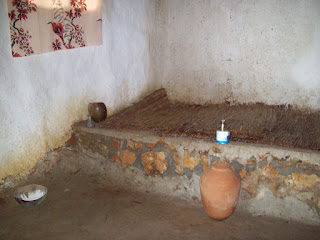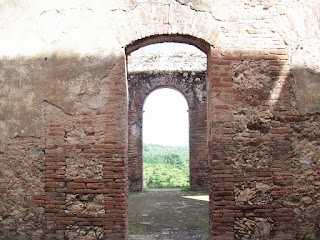Sunday, November 29, 2009
29 November 2009
Monday, November 23, 2009
23 November 2009 -- Going To Miami
Thursday, November 19, 2009
18 November 2009 –
17 November 2009 – Day in Cap Haitien, Haiti
16 November 2009 – Citadelle Laferriere Fortress, Haiti





The Citadelle is a tremendous statement about Haiti. It is a massive fort, with 375 cannons, built atop a mountain, by a Haitian King, Henri Cristophe. The Citadelle Laferriere fortress and the Sans Souci palace make up Haiti's World Heritage Site Henri Cristophe's thinking was very French in creating something so much like the Maginot Line. He was trying to protect his newly-independent nation from being recaptured by Napolean. When Haiti was a colony, forty-percent of the French Gross National Product came from the nearby agricultural lowlands. Napolean planned to retake Haiti to re-gain the agricultural income, and then use Haiti as a launch point to send his troops on to America and re-take the Louisiana Purchase. The original Citadelle would be a glimpse of what Haiti could have become if it stayed on the path set by the French. Somewhere the path veered and the story of the Citadelle mirrors Haiti’s fortunes. Locals loot it periodically and foreign organizations restore it periodically, but today it is so far gone that I was the only tourist registered by noon. The Citadelle gift shop was out of the dingy, under-sized picture books they used to sell for an outrageous $50. First rule of business, if something sells, re-order it. The only book they had for sale was a book of Japanese haikus written about the Citadelle. My guess is the demand for haikus is so small they never have to re-order. The walk up the mountain was the best part for me. From the town below, it is about a 2,500-foot climb. Afterwards it felt like running a half-marathon. The locals wanted to rent me a horse for $15. They acted like a foreigner would die if he tried walking the whole way. At least the horse was happy I walked.
16 November 2009 – San Souci, Haiti
15 November 2009 –
14 November 2009 – Letting Life Pass By
13 November 2009 -- Friday the Thirteenth, Haiti
Friday, November 13, 2009
4 November - 12 November 2009, Labadie, Haiti










Toured a potential marina site on the east side of Bay de L’Acul (N19 44.216’, W72 18.493’) with Maurice Laroche. Driving through impoverished areas in a Mercedes G-wagon puts a different perspective on Haiti. Here, the line between helping people and taking advantage of them can be quite blurry.
5 November 2009 – Blog Posting and Rest in Labadie, Haiti
Spent the morning posting to the Blog at Tim Mangs’ place. Spent the rest of the day taking it easy and getting ready for tomorrow’s trip to the Dominican Republic.
6 November 2009 – Back to the Dominican Republic
Tim and Dillon Mangs, along with myself, drove to Cabarete, Dominican Republic. We stopped at Unibank in Cap-Haitien for money. A simple debit card withdrawal took an hour. Functioning ATMs handle this easily in a minute. Tim and Dillon were looking forward to a vacation from Haiti and my main reason for going was to actually get a visa for Haiti. Until now, I was an illegal immigrant. In the Dominican Republic, we had a flat tire. The tire shop workers put on a beautiful display of the Dominican talent for organization. Fluid motions, with no wasted effort, made for a quick repair that would put almost any tire shop to shame. We checked in to a three-person suite for the night at Ali’s Surf Camp in Cabarete and ate their free supper.
7 November 2009 – Basking in Civilization, Sosua, Dominican Republic
Renewed my acquaintance with Elena, the manager of Ali’s Surf Camp. A 22-year-old Russian girl who has lived in Cabarete for four years and is one of the smartest, most competent people I have met. Some lucky guy will win the lottery when he marries her. Spent the afternoon at Bailey’s Restaurant in Sosua talking with Tim Schwartz and Peter. It was amazing to be surrounded by such relative modernity. ATMs and grocery stores were a welcome sight. For the evening, a smorgasboard of restaurants and a Jazz festival on the beach were a welcome diversion from the filth and squalor of Haiti.
8 November 2009 – Back to Luperon, Dominican Republic
We headed to Luperon, where we looked at a local boat building operation run by a French expat. Tim Mangs is looking to buy a boat for his shoreside excursion business. I ate lunch at Steve’s Place, the best value in gringo food around. Haitians have a terribly low per-capita caloric intake, so getting enough food to eat is hard in Haiti. Tim Schwartz jumped in with us and we drove to Monte Cristi, Dominican Republic, and spent the night at Hotel Milano, where $11 per night gets you a decent Dominican room.
9 November 2009 – Back to Cap Haitien, Haiti
Crossed the border into Haiti. This time, I actually did it legally. Once again it was market day, with thousands of people clogging the road. Tim Schwartz and I jumped out in Cap Haitien, went to the airport, and reserved tickets for a morning flight to Port-au-Prince to speak with the USAID Deputy Chief of Mission. After buying a cellphone, we spoke to the USAID guy and found out he was not available. That was fine with me because Jim Boernge had just sent me an email note that Mark Atchley, one of the guys mentioned in this blog sailing with Ray O’Quinn last February and March, had just died in a plane crash leaving St. Croix. We hung out in Cap Haitien for a few hours, seeing what was around. One of the girls Tim was talking to in Creole turned out to be a Jehovah’s Witness. We spent the night at Terez Boisette’s house, but the mosquitoes were too desperate to allow much sleep.
10 November 2009 – Back to Labadie, Haiti
Walked around Cap Haitien for awhile. Tim left to return to Sosua, Dominican Republic. I checked email at an Internet café and then rode the Tap-Tap back to Labadie. Got out of the Tap-Tap early to walk a side road that goes directly to where my kayak was stored and eliminate taking a water taxi. The mountains here make almost any walk good exercise.
11 November 2009 – Creole Lessons
First day of Creole lessons. Creole seems to be French Eubonics and Haiti is about the only place it is used. Noralis is a decent teacher, but I will soon hit the limits of his Creole-to-English translation ability. What scares me is that one day in Cap Haitien a girl asked Noralis where he learned Creole because it was different than her Creole. What kind of Creole am I learning?
12 November 2009 – The Boss is Gone
Spent the morning working on the computer trying to get a handle on some of the different projects and schemes floating around. Then went to a local Bed and Breakfast in Labadie named Norm’s Place, where Internet is usually available. Norm is 85-years-old and is currently in the hospital in the U.S. With Norm gone, there is no Internet. It is frightening how quickly things revert to nature when the boss is gone. Then spent about three hours surveying the harbor, paddling around in the kayak taking depth and GPS readings to build a chart of the harbor.
Thursday, November 5, 2009
3 November 2009 -- Haitian Cultural Tour at Paradise Island





































This morning I went on a very informative Haitian Cultural Tour at Paradise Cove. This tour is run by Tim and Dillon Mangs as a shoreside concession for Royal Caribbean Cruise Line from the cruise ship port of Labadee, Haiti. This tour departs from normal cruise ship entertainment fare by offering an educational look at authentic Haitian culture. Many of the ancient crafts showcased are still an important component of present Haitian life. Passengers load a 44-person excursion boat for a 10-minute ride along a scenic mountainous coastline, then disembark on a beautiful sandy beach, where they are served a complimentary rum punch at the Bamboo Bar. The tour begins with a short walk along the beach past a natural, freshwater stream, where a native dugout canoe is floating. Several native plants can be seen as people walk up the hill to the various exhibits: Natural Aloe, Pineapple, Sugarcane, Oranges, Limes, Coconuts, Bananas, and Plantains, Taro Roots. One of the first exhibits is a house under construction. It is built entirely of renewable, natural materials and the only tool used is a machete. A saw pit shows how logs are sawn by hand into boards. A fisherman sits in another hut weaving traps for lobster, crabs, and fish out of small stalks of flexible bamboo. Then the tour passes a charcoal pit, where wood is gathered from the high mountains and burned to create pure wood charcoal. This charcoal is still an important fuel for modern Haitian cooking. At one small house, a lady stands grinding peanut butter. After the peanuts are roasted, they are ground into natural peanut butter, an important local food rich in energy and protein. In the next house a lady is grinding coffee, and nearby a basket sits filled with the dried peels of the local oranges that are an essential ingredient of the French liqueur Gran Marnier. The path starts down to the beach past a young girl with a portable convenience store, the kind you see almost everywhere in Haiti. .A long shed houses a couple of local artisans. One man is a painter and the other is a wood sculptor. In the far end of the shed is a demonstration of Voodoo. The tour is almost complete as visitors walk down the hill, past the frame of a wooden boat and return to the beach, where they can drink at the bar, relas in a beach chair, or enjoy the cool ocean water and gentle waves. A link to more about this tour is at: Haitian Cultural Tour and a link to the RCCL booking page is at: Royal Caribbean Shoreside Excursions












